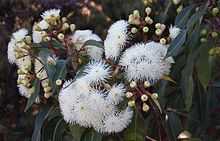- Corymbia calophylla
-
Marri 
C. calophylla, near Cataby Scientific classification Kingdom: Plantae (unranked): Angiosperms (unranked): Eudicots (unranked): Rosids Order: Myrtales Family: Myrtaceae Genus: Corymbia Species: C. calophylla Binomial name Corymbia calophylla
(R. Br.) K.D.Hill & L.A.S.JohnsonCorymbia calophylla (also known as Eucalyptus calophylla R. Br.) is a bloodwood native to Western Australia. Common names include Marri and Port Gregory Gum,[1] and a long standing usage has been Red Gum due to the red gum effusions often found on trunks.
It is distinctive among bloodwoods for its very large buds and fruit (colloquially "honky nuts" in Western Australia).
In 2009, Parra-O and colleagues published a combined analysis of nuclear rDNA (ETS + ITS) and morphological characters published to clarify relationships within the genus Corymbia. C. calophylla was found to form a natural group with two other Western Australian species C. ficifolia and C. haematoxylon. They classified the group as section Calophyllae within the subgenus Corymbia.[2]
It is related and somewhat similar to the Red-flowering Gum (Corymbia ficifolia). C. calophylla differs in being much larger (to about 50 metres (160 ft) high in the wild), having very much larger buds and fruit, and having flowers that are usually white to pink instead of red. However, in some areas hybridisation makes identification difficult.
Marri is widely distributed in the South-West of Western Australia, from north of Geraldton (28° S) to Cape Riche (34° S), and inland beyond Narrogin (32°56′S 117° E).
It is found on the Swan Coastal Plain and on the Darling Scarp showing its adaptability to the different environments.
It will grow on comparatively poor soil, but good specimens are considered an indicator of the better agricultural soils.
Contents
Uses
Marri timber is increasingly featured in modern household furniture. The timber is honey coloured and consists of a unique vein structure. However, it is not used in construction as the wood structure exhibits complex faults.
Notes
- ^ Holliday, I. and Watton, G. (1980). A Gardener's Guide to Eucalypts. Australia: Rigby. ISBN 0727012576.
- ^ Parra-o., Carlos; Bayly, Michael J.; Drinnan, Andrew; Udovicic, Frank; Ladiges, Pauline (2009). "Phylogeny, major clades and infrageneric classification of Corymbia(Myrtaceae), based on nuclear ribosomal DNA and morphology". Australian Systematic Botany 22 (5): 384-99. doi:10.1071/SB09028.
Reference
- Boland, D.J.; et al.. Forest Trees of Australia (5th Ed. ed.). Collingwood: CSIRO Publishing. ISBN 0-643-06969-0.
External links
- "Corymbia calophylla". FloraBase. Department of Environment and Conservation, Government of Western Australia. http://florabase.dec.wa.gov.au/browse/profile/17104.
Categories:- Corymbia
- Trees of Australia
- Drought-tolerant trees
- Trees of Mediterranean climate
- Myrtales of Australia
- Rosids of Western Australia
- Words and phrases of Australian Aboriginal origin
Wikimedia Foundation. 2010.
